Tour Our Chapel
Stained Glass Window of St. Teresa of Avila
With t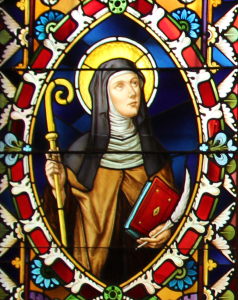 he Chapel baring the name of her hometown, St. Teresa of Avila has a special place as one of the magnificently restored stained glass windows. St. Teresa was born in Avila, Spain. St. Teresa grew in as a typical girl of her time, one who loved romance novels and attention. At the age of fifteen her father sent her to the convent to become a Carmelite nun. In her late life she set about a great reform to the Carmelite Order. She is known starting popular devotion to Saint Joseph; the Infant of Prague is also attributed to her as well. She was a mystical writer and wrote the great Spiritual Classic, The Interior Castle in which she describes the steps in the spiritual life. She was canonized on March 12, 1622 by Pope Gregory XV and proclaimed a Doctor of the Church on 27 September 1970 by Pope Paul VI. “Let nothing disturb you. Let nothing make you afraid. All things are passing. God alone never changes. Patience gains all things. If you have God you will want for nothing. God alone suffices.” — St Teresa, The bookmark of Teresa of Ávila.
he Chapel baring the name of her hometown, St. Teresa of Avila has a special place as one of the magnificently restored stained glass windows. St. Teresa was born in Avila, Spain. St. Teresa grew in as a typical girl of her time, one who loved romance novels and attention. At the age of fifteen her father sent her to the convent to become a Carmelite nun. In her late life she set about a great reform to the Carmelite Order. She is known starting popular devotion to Saint Joseph; the Infant of Prague is also attributed to her as well. She was a mystical writer and wrote the great Spiritual Classic, The Interior Castle in which she describes the steps in the spiritual life. She was canonized on March 12, 1622 by Pope Gregory XV and proclaimed a Doctor of the Church on 27 September 1970 by Pope Paul VI. “Let nothing disturb you. Let nothing make you afraid. All things are passing. God alone never changes. Patience gains all things. If you have God you will want for nothing. God alone suffices.” — St Teresa, The bookmark of Teresa of Ávila.
Stained Glass Window of St. Francis of Assisi
St. Francis of Assisi has the honor of being depicted in the other stained glass window. The first known saint to bare the stigmata, Francis’s childhood was full of charm and wealth. As a young man he became a soldier and was a prisoner of war. He returned to his party lifestyle when he returned from battle. At the age of twenty-five he felt God was 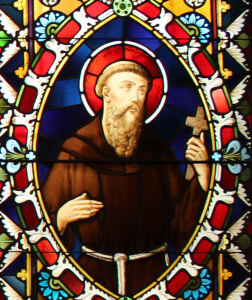 calling him to a more pious life. He left all his worldly processions and became a hermit. God told him to “rebuild his church.” He took on the challenge of rebuilding the Church of San Damiano, however God meant his church with a capital C. Francis founded the men’s Order of Friars Minor, the women’s Order of Saint Clare, the Third Order of Saint Francis and the Custody of the Holy Land. He is attributed to putting together the first Nativity Scene and is known for his love of animals. Pope Gregory IX canonised Francis on 16 July 1228. Along with Saint Catherine of Siena, he was designated Patron saint of Italy. He later became associated with patronage of animals and natural environment, which became customary for Catholic and Anglican churches to hold ceremonies blessing animals on his feast day of October 4. “Lord, make me an instrument of thy peace. Where there is hatred, let me sow love; Where there is injury, pardon; Where there is doubt, faith; Where there is despair, hope; Where there is darkness, light; Where there is sadness, joy.” – Part of the Prayer of Saint Francis.
calling him to a more pious life. He left all his worldly processions and became a hermit. God told him to “rebuild his church.” He took on the challenge of rebuilding the Church of San Damiano, however God meant his church with a capital C. Francis founded the men’s Order of Friars Minor, the women’s Order of Saint Clare, the Third Order of Saint Francis and the Custody of the Holy Land. He is attributed to putting together the first Nativity Scene and is known for his love of animals. Pope Gregory IX canonised Francis on 16 July 1228. Along with Saint Catherine of Siena, he was designated Patron saint of Italy. He later became associated with patronage of animals and natural environment, which became customary for Catholic and Anglican churches to hold ceremonies blessing animals on his feast day of October 4. “Lord, make me an instrument of thy peace. Where there is hatred, let me sow love; Where there is injury, pardon; Where there is doubt, faith; Where there is despair, hope; Where there is darkness, light; Where there is sadness, joy.” – Part of the Prayer of Saint Francis.
Cross of San Damiano
The crucifix that is in the chapel, as well as the other rooms in the house is called the Cross of San Damiano. This is the Cross that Saint Francis was praying before when he received the call to rebuild the church. What is unique about this particular cross is that it is sometimes called an “icon cross” because besides the main figure it contains images of other saints and people related to the incident of Christ’s crucifixion. Similar to other crucifixion crosses Jesus is the main and largest figure with the sign “King of Jews” nailed above his head. The next five larg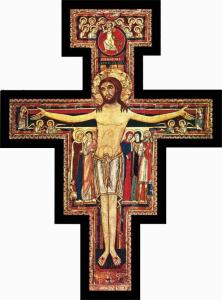 er figures are the Virgin Mary and Saint John the Evanglist on the left of Jesus. On his right side is Mary Magdalene; Mary, Mother of James; and the centurion who asks Jesus to heal his son (Matthew 8:5-11) who is seen peering over the shoulder of his father. The first four depicted are saints, therefore they have halos above their heads. The two smaller figures in the corners are the guards Longinus (left) and Stephaton (right). Longinus is known as the soldier who pierced the side of Jesus with the lance, hence why the blood is dripping toward his upturned face. Stephaton is the soldier who offered Jesus the sponge of vinegar water. Six angels are on the crossbars of the crucifixion, while six Saints are below looking up at it. Those six saints are St. Damian, St. Michael, St. Rufino, St. John the Baptist, St. Peter and St. Paul. On the top of the cross, one sees Jesus now fully clothed in his regal garments and carrying the cross as a triumphant sceptre. He is climbing out of the tomb and into the heavenly courts. Ten angels are crowded around, five of whom have their hands extended in a welcoming gesture to Jesus, who himself has his hand raised in the form of a greeting. At the very top of the cross is the Hand of God with two fingers extended. This is to be understood as the blessing of God the Father on the sacrifice of his Son. On the right side of Jesus is a small picture of a fowl, it is either a rooster or a peacock. “Most High, glorious God, enlighten the darkness of my heart and give me true faith, certain hope and perfect charity, sense and knowledge, Lord, that I may carry out Your holy and true command.” -The Prayer before the Crucifix at San Damiano. The Cross of San Damiano is big fixture in the Hope House Retreat Center and can be found in every room of the house. If you would like to purchase your own similar version of the cross, it can be found here or by calling 814-455-7364.
er figures are the Virgin Mary and Saint John the Evanglist on the left of Jesus. On his right side is Mary Magdalene; Mary, Mother of James; and the centurion who asks Jesus to heal his son (Matthew 8:5-11) who is seen peering over the shoulder of his father. The first four depicted are saints, therefore they have halos above their heads. The two smaller figures in the corners are the guards Longinus (left) and Stephaton (right). Longinus is known as the soldier who pierced the side of Jesus with the lance, hence why the blood is dripping toward his upturned face. Stephaton is the soldier who offered Jesus the sponge of vinegar water. Six angels are on the crossbars of the crucifixion, while six Saints are below looking up at it. Those six saints are St. Damian, St. Michael, St. Rufino, St. John the Baptist, St. Peter and St. Paul. On the top of the cross, one sees Jesus now fully clothed in his regal garments and carrying the cross as a triumphant sceptre. He is climbing out of the tomb and into the heavenly courts. Ten angels are crowded around, five of whom have their hands extended in a welcoming gesture to Jesus, who himself has his hand raised in the form of a greeting. At the very top of the cross is the Hand of God with two fingers extended. This is to be understood as the blessing of God the Father on the sacrifice of his Son. On the right side of Jesus is a small picture of a fowl, it is either a rooster or a peacock. “Most High, glorious God, enlighten the darkness of my heart and give me true faith, certain hope and perfect charity, sense and knowledge, Lord, that I may carry out Your holy and true command.” -The Prayer before the Crucifix at San Damiano. The Cross of San Damiano is big fixture in the Hope House Retreat Center and can be found in every room of the house. If you would like to purchase your own similar version of the cross, it can be found here or by calling 814-455-7364.
Exposition Tabernacle
Behind our handsome wooden altar is the exposition tabernacle. We are blessed at the Hope House Retreat Center to have Jesus present in the Avila Chapel twenty-four hours a day. The 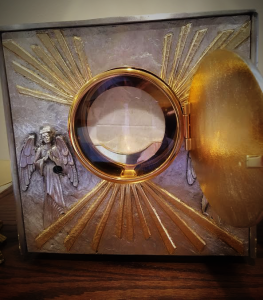 exposition tabernacle can be used for Mass and personal reflection time. Retreatants may open the golden door to expose Jesus if they desire to prayer in front of the Blessed Sacrament during a silent retreat. The tabernacle is silver with the On the wall above the altar is Psalm 46:10 “Be still and know that I am God.”
exposition tabernacle can be used for Mass and personal reflection time. Retreatants may open the golden door to expose Jesus if they desire to prayer in front of the Blessed Sacrament during a silent retreat. The tabernacle is silver with the On the wall above the altar is Psalm 46:10 “Be still and know that I am God.”
Statues of Mary and Joseph
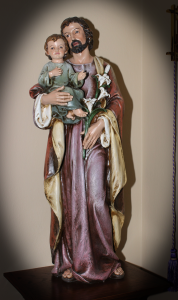 In the corners of either side of the altar are two statues; the Virgin Mother and St. Joseph. As the parents of Jesus, these two marvelous saints can be found in Catholic churches worldwide. St. Joseph was a descendant of the house of David. Layman. Carpenter. Earthly spouse of the Blessed Virgin Mary. Foster and adoptive father of Jesus Christ. Visionary who was visited by angels. Noted for his willingness to immediately get up and do what God told him. Scripture states that Jesus was “obedient to him” (Luke 2:51).”Jacob was the father of Joseph the husband of Mary. It was of her that Jesus who is called the Messiah was born.” (Matthew 1:16). O blessed Joseph, faithful guardian of my Redeemer, Jesus Christ, protector of thychaste spouse, the virgin Mother of God, I choose thee this day to be my special patron and advocate and I firmly resolve to honor thee all the days of my life. Therefore I humbly beseech thee to receive me as thy client, to instruct me in every doubt, to comfort me in every affliction, to obtain for me and for all the knowledge and love of the Heart of Jesus, and finally to defend and protect me at the hour of my death. Amen His feast day is March 19.
In the corners of either side of the altar are two statues; the Virgin Mother and St. Joseph. As the parents of Jesus, these two marvelous saints can be found in Catholic churches worldwide. St. Joseph was a descendant of the house of David. Layman. Carpenter. Earthly spouse of the Blessed Virgin Mary. Foster and adoptive father of Jesus Christ. Visionary who was visited by angels. Noted for his willingness to immediately get up and do what God told him. Scripture states that Jesus was “obedient to him” (Luke 2:51).”Jacob was the father of Joseph the husband of Mary. It was of her that Jesus who is called the Messiah was born.” (Matthew 1:16). O blessed Joseph, faithful guardian of my Redeemer, Jesus Christ, protector of thychaste spouse, the virgin Mother of God, I choose thee this day to be my special patron and advocate and I firmly resolve to honor thee all the days of my life. Therefore I humbly beseech thee to receive me as thy client, to instruct me in every doubt, to comfort me in every affliction, to obtain for me and for all the knowledge and love of the Heart of Jesus, and finally to defend and protect me at the hour of my death. Amen His feast day is March 19.
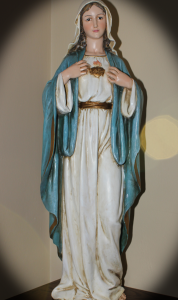 Our Blessed Mother was only a young teenage when she utter the words “I am the handmaid of the Lord; Let it be done to me as you say” (Luke 1:38). She was with him through out his life and public ministry, including his death. Her feast days are January 1 – Solemnity of Mary; February 2 – Presentation of the Lord; February 11- Our Lady of Lourdes; March 25 – Annunciation; May 31 – Visitation; June 27 – Our Mother of Perpetual Help; July 16 – Our Lady of Mount Carmel; August 15 – Assumption August 22 – Queenship of Mary; September 8 – Birth of Mary; September 12 – The Most Holy Name of Mary; September 15 – Our Lady of Sorrows; October 7 – Our Lady of the Rosary; November 21 – Presentation of the Blessed Virgin Mary; December 8 – Immaculate Conception; December 12 – Our Lady of Guadalupe. Remember, O most gracious Virgin Mary, that never was it known that anyone who fled to your protection, implored your help or sought your intercession was left unaided. Inspired with this confidence, I fly to you, O virgin of virgins, my Mother. To you I come, before you I stand, sinful and sorrowful. O Mother of the Word Incarnate, despise not my petitions, but in your mercy, hear and answer me. Amen.
Our Blessed Mother was only a young teenage when she utter the words “I am the handmaid of the Lord; Let it be done to me as you say” (Luke 1:38). She was with him through out his life and public ministry, including his death. Her feast days are January 1 – Solemnity of Mary; February 2 – Presentation of the Lord; February 11- Our Lady of Lourdes; March 25 – Annunciation; May 31 – Visitation; June 27 – Our Mother of Perpetual Help; July 16 – Our Lady of Mount Carmel; August 15 – Assumption August 22 – Queenship of Mary; September 8 – Birth of Mary; September 12 – The Most Holy Name of Mary; September 15 – Our Lady of Sorrows; October 7 – Our Lady of the Rosary; November 21 – Presentation of the Blessed Virgin Mary; December 8 – Immaculate Conception; December 12 – Our Lady of Guadalupe. Remember, O most gracious Virgin Mary, that never was it known that anyone who fled to your protection, implored your help or sought your intercession was left unaided. Inspired with this confidence, I fly to you, O virgin of virgins, my Mother. To you I come, before you I stand, sinful and sorrowful. O Mother of the Word Incarnate, despise not my petitions, but in your mercy, hear and answer me. Amen.
The Stations of the Cross
Our Stations are depicted on the back wall of the Chapel. Each station shows the Way of the Cross. The Stations of the Cross began as the practice of pious pilgrims to Jerusalem who would retrace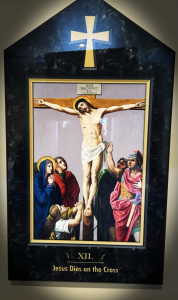 the final journey of Jesus Christ to Calvary. Later, for the many who wanted to pass along the same route, but could not make the trip to Jerusalem, a practice developed that eventually took the form of the fourteen stations currently found in almost every church. This particular set in the Avila Chapel are printed on marbled, glossy-finish wall icon plaques with a beveled edge. If you would like to pray the Stations of the Cross it can be found here.
the final journey of Jesus Christ to Calvary. Later, for the many who wanted to pass along the same route, but could not make the trip to Jerusalem, a practice developed that eventually took the form of the fourteen stations currently found in almost every church. This particular set in the Avila Chapel are printed on marbled, glossy-finish wall icon plaques with a beveled edge. If you would like to pray the Stations of the Cross it can be found here.
Sic Deus Dilexit Mundum
Sic Deus Dilexit Mundum, “For God So Loved the World” (John 3:16), is one of our most beloved paintings in the Catholic faith. As far as we know the original painting was 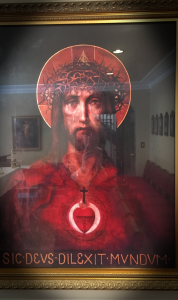 painted in the 1700’s by an unknown artist. This beautiful image was saved from a centuries-old church that was destined for destruction and brought to the United States as a heirloom for a family in Michigan. It bears a resemblance to the Shroud of Turin, which is the burial Turin if Jesus. Jesus’s wound is illuminated by what is believed to be a large Host behind it. It is burning with the love his has for Mankind. The tears on Jesus’ cheeks remind us of St. Margaret Mary’s great apparition in which Jesus said, “Behold the Heart that so loved men…instead of gratitude I receive from the greater part only ingratitude…” O most holy heart of Jesus, fountain of every blessing, I adore you, I love you, and with lively sorrow for my sins I offer you this poor heart of mine. Make me humble, patient, pure and wholly obedient to your will. Grant, Good Jesus, that I may live in you and for you. Protect me in the midst of danger. Comfort me in my afflictions. Give me health of body, assistance in my temporal needs, your blessing on all that I do, and the grace of a holy death. Amen.
painted in the 1700’s by an unknown artist. This beautiful image was saved from a centuries-old church that was destined for destruction and brought to the United States as a heirloom for a family in Michigan. It bears a resemblance to the Shroud of Turin, which is the burial Turin if Jesus. Jesus’s wound is illuminated by what is believed to be a large Host behind it. It is burning with the love his has for Mankind. The tears on Jesus’ cheeks remind us of St. Margaret Mary’s great apparition in which Jesus said, “Behold the Heart that so loved men…instead of gratitude I receive from the greater part only ingratitude…” O most holy heart of Jesus, fountain of every blessing, I adore you, I love you, and with lively sorrow for my sins I offer you this poor heart of mine. Make me humble, patient, pure and wholly obedient to your will. Grant, Good Jesus, that I may live in you and for you. Protect me in the midst of danger. Comfort me in my afflictions. Give me health of body, assistance in my temporal needs, your blessing on all that I do, and the grace of a holy death. Amen.
Divine Mercy Picture
In 1931, Jesus appeared to Sister Faustina in a vision. In her vision our Lord was clothed in white, with two rays beaming out of his heart; one red and one pale. Jesus told her to paint the image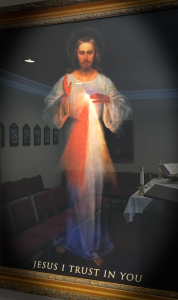 she saw before her. He went on to tell her the red ray of light represents blood which is the life for souls, the pale one represents water which makes souls righteous. He also wanted the image captioned with the words “Jesus I Trust In You.” According to her diary Jesus told her “I promise that the soul that will venerate this image will not perish. I also promise victory over [its] enemies already here on earth, especially at the hour of death. I Myself will defend it as My own glory (Diary, 47, 48). I am offering people a vessel with which they are to keep coming for graces to the fountain of mercy. That vessel is this image with the signature: Jesus, I trust in You (327). I desire that this image be venerated, first in your chapel, and then throughout the world.” Eternal Father, I offer you the Body and Blood, Soul and Divinity of Your Dearly Beloved Son, Our Lord, Jesus Christ, in atonement for our sins and those of the whole world. – The Eternal Father, Divine Mercy Chaplet.
she saw before her. He went on to tell her the red ray of light represents blood which is the life for souls, the pale one represents water which makes souls righteous. He also wanted the image captioned with the words “Jesus I Trust In You.” According to her diary Jesus told her “I promise that the soul that will venerate this image will not perish. I also promise victory over [its] enemies already here on earth, especially at the hour of death. I Myself will defend it as My own glory (Diary, 47, 48). I am offering people a vessel with which they are to keep coming for graces to the fountain of mercy. That vessel is this image with the signature: Jesus, I trust in You (327). I desire that this image be venerated, first in your chapel, and then throughout the world.” Eternal Father, I offer you the Body and Blood, Soul and Divinity of Your Dearly Beloved Son, Our Lord, Jesus Christ, in atonement for our sins and those of the whole world. – The Eternal Father, Divine Mercy Chaplet.
Our Lady of Guadalupe
In 1531 Juan, an Aztec peasant, was walking to the chapel when a beautiful woman appeared to him. The women, the Virgin Mother, spoke to him in his native tongue and told him who she was and sent him to the Bishop in Tenochtitlan. She wanted a Church built where they were. After many trips to and from the hill where he first met Mary, Juan 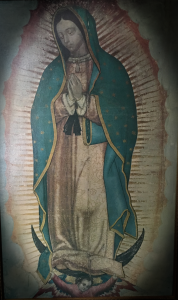 was unsuccessful in procuring the Bishop’s approval. Finally, Mary told him to retrieve some flowers on top of the hill and bring them to her. She arranged the flowers in his tilma and told him to give them to the Bishop as an offering. The next day in front of the Bishop and several of his advisors, Juan opened the tilma to reveal an image of the Virgin Mother, exactly as Juan described her to people. She told his uncle to call her Santa Maria de Guadalupe. Within six years of the apparition six million Aztecs converted to Catholicism. The tilma shows Mary as the God-bearer – she is pregnant with her Divine Son. Since the time the tilma was first impressed with a picture of the Mother of God, it has been subject to a variety of environmental hazards including smoke from fires and candles, water from floods and torrential downpours and, in 1921, a bomb which was planted by anti-clerical forces on an altar under it. The tilma survived and no one in the church was injured, despite the horrible damage. Our Lady of Guadalupe is the most popular pilgrimage in the Western Hemisphere. Our Lady of Guadalupe, Mystical Rose, make intercession for the Holy Church, protect the Sovereign Pontiff, help all those who invoke thee in their necessities, and since thou art the ever Virgin Mary, and Mother of the True God, obtain for us from thy most holy Son the grace of keeping our faith, of sweet hope in the midst of the bitterness of life, of burning charity, and the precious gift of final perseverance. Amen.
was unsuccessful in procuring the Bishop’s approval. Finally, Mary told him to retrieve some flowers on top of the hill and bring them to her. She arranged the flowers in his tilma and told him to give them to the Bishop as an offering. The next day in front of the Bishop and several of his advisors, Juan opened the tilma to reveal an image of the Virgin Mother, exactly as Juan described her to people. She told his uncle to call her Santa Maria de Guadalupe. Within six years of the apparition six million Aztecs converted to Catholicism. The tilma shows Mary as the God-bearer – she is pregnant with her Divine Son. Since the time the tilma was first impressed with a picture of the Mother of God, it has been subject to a variety of environmental hazards including smoke from fires and candles, water from floods and torrential downpours and, in 1921, a bomb which was planted by anti-clerical forces on an altar under it. The tilma survived and no one in the church was injured, despite the horrible damage. Our Lady of Guadalupe is the most popular pilgrimage in the Western Hemisphere. Our Lady of Guadalupe, Mystical Rose, make intercession for the Holy Church, protect the Sovereign Pontiff, help all those who invoke thee in their necessities, and since thou art the ever Virgin Mary, and Mother of the True God, obtain for us from thy most holy Son the grace of keeping our faith, of sweet hope in the midst of the bitterness of life, of burning charity, and the precious gift of final perseverance. Amen.
